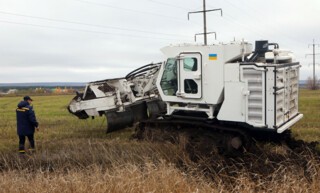Demining Ukraine
Nick McDonell
Early on 24 July, a Russian missile struck the Kharkiv office of Fondation Suisse de Déminage, a mine-clearing organisation. The missile – probably a medium-range ballistic Iskander-M – blew open the second, third and fourth floors of the building and damaged several vehicles. Fortunately, it didn’t kill or injure any staff.
One morning last summer, an hour east of Kharkiv, at the edge of an overgrown field, I watched as three de-miners from the State Emergency Service of Ukraine strapped on their body armour. They were led by a 22-year-old I’ll call Artem, whose predecessor had recently lost a foot. Artem, Borys and Bogdan (also not their names) had been tasked with clearing a path under the power lines that bordered the field, so technicians could safely restore electricity to nearby villages. The field had been fought over and was likely to be dense with mines and unexploded ordnance.
They’d cleared about four hundred metres the day before with their demining vehicle, a white Armtrac, which looked like a cross between a tank and thresher. Its front was equipped with a blast hood and a nine-foot rotor hung with dozens of steel flails to churn the earth and detonate mines. According to one of the men at the motor pool, the Armtrac was twenty years old and had been in Syria. The windscreen was cracked. It ran well enough, though, as long as they kept it oiled, which the fourth member of the squad, Max (another alias), had gone ahead to do.
The morning was hot and no shade fell on the men in their black armour as they walked to their vehicle, careful to stay on the cleared path. ‘Someone turned on the heat,’ Artem said. His bucket hat made him look even younger than he was. ‘What does the management say about it?’ (‘The management’ was their joke term for forces beyond their control.)
‘They turned off their phone,’ said Borys. He used to be a policeman. ‘They said it will be eight hundred degrees, and we need to work. And next week it will be minus three hundred.’
The men arrived, sweating, at their vehicle. Max hopped down from the cockpit. He wore a black T-shirt printed with the words ‘Cassius Clay’.
‘What do we have to do today?’ he asked.
‘From here to that pole,’ Artem said, pointing to a pylon about a kilometre away.
In between, some power lines hung intact, others dangled down to the ground. Many of the poles were bare, indicating that their lines lay on the ground. This was a problem. The Armtrac’s rotor would snag on the fallen lines. It had happened before, and cutting power lines from the rotor was miserable work.
‘We need to do something with those lines,’ Bogdan said.
‘Let’s pick them up and move them,’ Artem said. ‘Unless you have another idea?’
‘I don’t.’
Artem hesitated. The safer but slower option was to walk behind the vehicle, and, when it snagged, cut the rotor loose. But this could take days and was bad for the vehicle. Walking ahead through the fallen lines and moving them by hand would be more efficient – but more dangerous. Any one of them, no matter how careful, could miss a mine in the dense tall grass and lose a leg, or worse.
‘Should we just reel a line in?’ Artem said, returning to the safer option.
‘Yeah, and cut it off,’ Borys finished.
‘I won’t cut them off, by the way,’ Max said.
‘Yes you will, by the way,’ Borys replied.
Max got in the Armtrac. He started the engine, drove towards the next pylon. The rest of the squad followed on foot. For several minutes, the Armtrac made steady progress, churning the earth, revealing neither mines nor power lines. Then it screeched and began to smoke.
Max killed the engine and went to have a look. The rotor, as feared, had spun up a power line like steel spaghetti. Borys and Bogdan went to work cutting it off with shears and a hand-held circular saw, squinting against the sparks. Soon, unhappily, Max joined in. After an hour of hot, back-twisting saw work, they’d cleared the rotor. At this rate, if they snagged again, they wouldn’t complete the mission on schedule.
Max had had enough. Rather than starting the vehicle, he looked from his squad to the field. Then he walked purposefully ahead, into the weeds, eyes down. Borys sighed and followed. Then Bogdan and, finally, Artem.
Less than twenty metres ahead they found the next power line. They hefted the braided steel over their shoulders and dragged it out of the way. Then they retraced their steps through the grass they’d flattened, back to the vehicle, and drove it on to the next pole. And so on. By sunset, they’d finished the job safely. The risk had paid off.
But every day required new calculations. What were they willing to risk to get the job done faster? How urgent, really, was the work? At the nearest hospital, surgeons told me they treated civilians injured by landmines or unexploded ordnance every week. I met a farmer who’d been blinded and a mechanic who’d lost his right foot and ankle.
Ele Porritt, the project manager at the FSD office destroyed last month, estimated that, countrywide, every year of conflict would require ten years of mine clearance. Some mines are likely to remain long after Putin is gone from the Kremlin. The week before Artem and his team cleared the power lines, another team, twenty kilometres south, had discovered and disarmed unexploded mortar rounds from the Second World War.

Comments